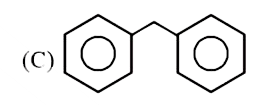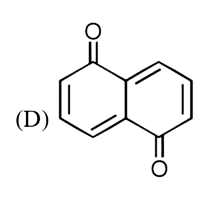In which of the following molecules all the atoms lie in one plane ? .
CH4
BF3
PF5
NH3
The correct Answer is:B
To determine which of the given molecules has all its atoms lying in one plane, we will analyze each molecule based on its hybridization and molecular geometry.
1. Analyze CH4 (Methane):
- The carbon atom in CH4 is sp³ hybridized.
- In sp³ hybridization, the geometry is tetrahedral.
- This means that the four hydrogen atoms are not in the same plane; they are arranged in three-dimensional space.
- Conclusion: CH4 does not have all atoms in one plane.
2. Analyze BF3 (Boron Trifluoride):
- The boron atom in BF3 is sp² hybridized.
- In sp² hybridization, the geometry is trigonal planar.
- This means that the three fluorine atoms are arranged in the same plane with bond angles of 120 degrees.
- Conclusion: BF3 has all atoms in one plane.
3. Analyze PF5 (Phosphorus Pentafluoride):
- The phosphorus atom in PF5 is sp³d hybridized.
- The geometry is trigonal bipyramidal.
- In this structure, there are two fluorine atoms positioned above and below the plane of the three fluorine atoms, which lie in a plane.
- Conclusion: PF5 does not have all atoms in one plane.
4. Analyze NH3 (Ammonia):
- The nitrogen atom in NH3 is sp³ hybridized.
- The geometry is also tetrahedral.
- NH3 has one lone pair and three hydrogen atoms, which means that the hydrogen atoms are not all in the same plane.
- Conclusion: NH3 does not have all atoms in one plane.
Final Answer:
The molecule in which all the atoms lie in one plane is BF3.
---
- The carbon atom in CH4 is sp³ hybridized.
- In sp³ hybridization, the geometry is tetrahedral.
- This means that the four hydrogen atoms are not in the same plane; they are arranged in three-dimensional space.
- Conclusion: CH4 does not have all atoms in one plane.
- The boron atom in BF3 is sp² hybridized.
- In sp² hybridization, the geometry is trigonal planar.
- This means that the three fluorine atoms are arranged in the same plane with bond angles of 120 degrees.
- Conclusion: BF3 has all atoms in one plane.
- The phosphorus atom in PF5 is sp³d hybridized.
- The geometry is trigonal bipyramidal.
- In this structure, there are two fluorine atoms positioned above and below the plane of the three fluorine atoms, which lie in a plane.
- Conclusion: PF5 does not have all atoms in one plane.
- The nitrogen atom in NH3 is sp³ hybridized.
- The geometry is also tetrahedral.
- NH3 has one lone pair and three hydrogen atoms, which means that the hydrogen atoms are not all in the same plane.
- Conclusion: NH3 does not have all atoms in one plane.
The molecule in which all the atoms lie in one plane is BF3.
Topper's Solved these Questions
- CHEMICAL BONDING AND MOLECULAR STRUCTUREBOOK - CENGAGE CHEMISTRYCHAPTER - CHEMICAL BONDING AND MOLECULAR STRUCTUREEXERCISE - Exercises Single Correct (Resonance And Formal Charges)
10 Videos
- CHEMICAL BONDING AND MOLECULAR STRUCTUREBOOK - CENGAGE CHEMISTRYCHAPTER - CHEMICAL BONDING AND MOLECULAR STRUCTUREEXERCISE - Exercises Single Correct (Molecular Orbital Theory (Mot))
23 Videos
- CHEMICAL BONDING AND MOLECULAR STRUCTUREBOOK - CENGAGE CHEMISTRYCHAPTER - CHEMICAL BONDING AND MOLECULAR STRUCTUREEXERCISE - Exercises Single Correct (Hybridisation)
33 Videos
- ATOMIC STRUCTUREBOOK - CENGAGE CHEMISTRYCHAPTER - ATOMIC STRUCTUREEXERCISE - Concept Applicationexercise(4.3)
19 Videos
- CHEMICAL EQUILIBRIUMBOOK - CENGAGE CHEMISTRYCHAPTER - CHEMICAL EQUILIBRIUMEXERCISE - Archives (Subjective)
11 Videos
Similar Questions
Knowledge Check
In which of the following molecules, all atoms are not coplanar ?
A B
B C
C D
D
In which of the following moleucles, all atoms are coplanar?
A B
B C
C D
D
In which of the following molecules, all atoms are coplanar ?
A B
B C
C D
D
In which of the following molecules all the bonds are not equal:-
View SolutionIn how many of the following molecules, all atoms are in same plane?

View SolutionIn which of the following molecule/ion all the bonds are not equal?
View SolutionIn which of the following molecule/ion all the bonds are not equal?
View SolutionIn which of the following molecule/ion, all the bonds are not equal?
View Solution